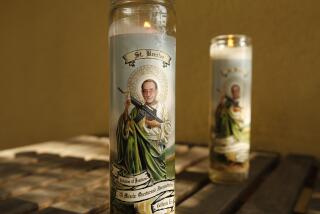R.J. Reynolds Fined for Ads Aimed at Teens
- Share via
A San Diego judge fined R.J. Reynolds Tobacco Co. $20 million Thursday after finding that the nation’s No. 2 cigarette maker was targeting teenagers by advertising Camels and other brands in magazines such as InStyle, Spin and Hot Rod.
The fine is the first financial penalty imposed for a violation of the 1998 settlement of lawsuits against tobacco firms filed by the attorneys general of 46 states. Under that settlement, the cigarette makers pledged to pay the states $246 million over 25 years.
At issue in this case was the companies’ agreement to take no action, “directly or indirectly, to target youth.” Although the 1998 settlement made no specific mention of magazine advertising, California Atty. Gen. Bill Lockyer charged RJR last year with breaching the agreement by placing ads in magazines popular with readers under age 18.
San Diego County Superior Court Judge Ronald S. Prager agreed that such advertisements violated that ban, and he ordered RJR to “reduce youth exposure” to its cigarette ads and to demonstrate its compliance.
Lockyer said the ruling would help meet one of the key goals of the tobacco litigation and settlement, which was to keep children from taking up smoking. “When hundreds of your customers die every day, the only way to stay in business is to hook new ones,” he said. “But targeting children in your quest for new consumers is unlawful, shameful and will not be tolerated in California.”
RJR’s top lawyer said the company would appeal, and he maintained that its advertising strategy complies with the settlement by avoiding any publication that draws 25% or more of its readership from youths.
“The attorney general conceded that we have no specific intent to target youth with magazine advertising, and that we do not purposefully attempt to expose youth to our advertising,” said Charles Blixt, RJR’s general counsel. This ruling “says that if we advertise in magazines whose readership is overwhelmingly adults and some kids may see cigarette advertising in the magazine, that is a violation of the provision that we do nothing to target youth.
“It’s inconsistent with the agreement,” Blixt said. “It’s inconsistent with the law, and it’s inconsistent with our 1st Amendment right to advertise to adults in these magazines.”
Anti-smoking organizations hailed the ruling as a sign that the 1998 settlement will be vigorously enforced.
“This is a shot across the bow to R.J. Reynolds,” said Matt Myers, president of the Washington-based National Center for Tobacco Free Kids. “This decision gives real teeth to the settlement agreement’s prohibitions against marketing to children and is a critical judicial finding that R.J. Reynolds continued to target kids long after the settlement.”
In the wake of the November 1998 settlement, tobacco companies imposed their own guidelines for curtailing the number of readers under 18 who might see pitches for cigarettes. Philip Morris Cos., the nation’s No. 1 tobacco company, pledged to refrain from advertising in magazines with more than 15% youth readership. Brown & Williamson Tobacco Corp. said it observes a 15% limit. Lorillard Tobacco said it restricts its ads to magazines with 18% or less youth readership.
With the highest self-imposed limit of 25% youth readers, Reynolds is viewed by Lockyer’s office as the most aggressive of the tobacco companies in its tactics for pitching its brands.
“They’re always pushing the envelope as to what they can get away with,” said one attorney in Lockyer’s office, “so as a result they’re going to get sued more.”
RJR’s Blixt said the attorneys general failed in an attempt to obtain specific magazine advertising limits during negotiations that led to the 1998 settlement. “The attorney general is trying to litigate to get more than was gotten through negotiation,” he said.
The $20-million sanction is the fourth victory in the last 18 months for Lockyer against RJR. Last month, a Los Angeles judge ordered RJR to pay fines of $15 million for handing out free cigarettes at the Pomona fairgrounds and other locations where children were present. State law limits the free distribution of cigarettes to places that are off-limits to minors.
Lockyer also had sued RJR over ad signs posted at car-racing venues. The state claimed the ads violated the national tobacco settlement. Prager agreed and ordered the signs to come down but assessed no fine. In January 2001, Lockyer’s office reached a settlement with RJR concerning its disputed practice of mailing cigarettes to consumers without determining that they were at least 18.
Prager is presiding over two class-action lawsuits filed against tobacco companies on behalf of California cigarette buyers. One, which is set for trial next month, demands the tobacco firms refund the money underage buyers spent on cigarettes from 1995 to 2000.
Analysts said neither the fine levied Thursday nor a curtailment of magazine advertising would harm the $6.6-billion company. “This is not a big deal,” said Bonnie Herzog, an analyst with Salomon Smith Barney. “In principle it’s a big deal to them, so they are going to appeal.”
But even if RJR loses on appeal and is forced to pull some of its magazine ads, Herzog said the effect would be minimal because such print campaigns are a small part of its marketing strategy.
Shares of Winston-Salem, N.C.-based R.J. Reynolds Tobacco Holdings Inc. fell $1.08 to $68.71 on the New York Stock Exchange.
More to Read
Inside the business of entertainment
The Wide Shot brings you news, analysis and insights on everything from streaming wars to production — and what it all means for the future.
You may occasionally receive promotional content from the Los Angeles Times.











